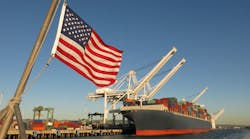As a result of my writing and speaking about returning manufacturing to America through reshoring, I recently received information from the International Economic Development Council (IEDC) inviting me to educate my audience on the findings of their research and the tools and resources available when manufacturers are considering reshoring.
The IEDC is a non-profit membership organization serving economic developers with more than 4,700 members. Their mission as economic developers is to "promote economic well-being and quality of life for their communities, by creating, retaining and expanding jobs that facilitate growth, enhance wealth and provide a stable tax base."
Last year, the IEDC received a grant from the U.S. Economic Development Administration to "examine current reshoring practices and create materials to spread awareness of reshoring trends, tools and resources that are available to ease the process." For the past 16 months, IEDC has conducted research on why companies are choosing to reshore and what resources are available to assist American companies that are considering reshoring. In the past year, IEDC has provided educational training sessions with reshoring experts, such as Harry Moser of the Reshoring Initiative, for economic developers.
IEDC also created the Reshoring American Jobs webpage, a project funded by the U.S. Economic Development Administration (EDA). "It is the go-to place to learn about and find resources to support activities encouraging reshoring in communities. Economic developers will find the latest news, case studies, and in-depth research on reshoring activity to help them stay in-the-know on reshoring trends information." The micro site is divided into three sections:
1. Understanding Reshoring" discusses the critical role reshoring plays in strengthening the economy, identifies challenges to reshoring, and highlights lessons learned from communities that have worked with reshored companies."
- Defining the Reshoring Discussion" white paper
- National Assessment of Reshoring Activities
- Webinars: Defining the Reshoring Discussion, Reshoring Tools….They’re Out There
2. Tools for Reshoring "provides resources and best practices in reshoring American jobs to aid economic developers in assisting reshoring companies."
3. Reshoring in the Media "tracks the latest discussions on trends covered by popular and trade media. The content will help demystify the reshoring movement and serves as a practical reference for economic development professionals."
In March 2016, IEDC published a 30-page white paper on "Defining the Reshoring Discussion, "in which the introduction and historical perspective states, "…as foreign countries strengthened their manufacturing competitiveness over the years, American manufacturers struggled to maintain their cost and productivity advantages on a global scale. Some American manufacturers adjusted to foreign competition by shifting their focus to complex, high-value products and industries—and increasing manufacturing investment, output, and employment. Others either closed U.S.-based factories or sought cost savings by offshoring some, or all, of their operations to less expensive foreign locations. Shortly after China joined the World Trade Organization at the end of 2001, a large exodus of U.S. manufacturers occurred."
Now, however, supply chain dynamics have changed, and the report states, "…the cost savings that American firms had enjoyed began to erode around the year 2010. Changing macro-economic factors, such as labor and transportation cost increases, absorbed much of the savings from which manufacturers had previously benefitted. Also, after experiencing offshoring firsthand, many companies found that hidden costs often outweighed the cost benefits of manufacturing overseas. Some of these hidden costs that were not always considered include factors such as increased costs of monitoring and quality control, uncertain protection of intellectual property, and lengthy supply chains."
While the white paper presents a broad overview of the discussion of reshoring, some common themes emerged from their review of resources:
- "The decision to reshore is often described as a response by business to both macroeconomic and internal business-related factors.
- The term reshoring is used to describe a range of activities that occur in numerous industries, not just manufacturing.
- A company’s decision to reshore can be encouraged through the creation of favorable business conditions, a skilled workforce, and incentives that encourage innovative manufacturing practices.
- Reshored jobs will likely be different from the jobs that existed before offshoring gained momentum or jobs that currently exist offshore."
The reason economic development agencies have become interested in reshoring is that "The impacts of reshoring extend beyond individual companies and provide benefits for entire regions as the effects multiply through local economies."
From an economic development viewpoint, "it is important to understand that reshoring is fundamentally a location decision. In this sense, a company’s decision to stay in the U.S. or relocate will be based on its total operation costs in a given location."
The white paper highlights some of the findings of the data from 25 national economies studied by the Boston Consulting Group (BCG) from 2004 to 2014. The BCG study found that the following factors significantly impact manufacturing location decisions:
- Increased wages – "China's wages rose 15 to 20% per year at the average Chinese factory"
- Fluctuating currency value – "when compared against the U.S. dollar, the Chinese yuan increased in value by 35%
- "Labor productivity, which is measured as the gains in output per manufacturing worker"
- "Reduction of energy costs from 2004 to 2014, especially in energy-dependent industries such as iron and steel and chemicals industries"
Naturally, the white paper mentions the work of Harry Moser, founder of the Reshoring Initiative, in developing the Total Cost of Ownership Estimator in an effort "to help decision-makers estimate total costs of outsourced parts or products by aggregating, then quantifying all cost and risk factors into a single cost."
The paper then discusses the different definitions of reshoring from a popular understanding to a more academic definition. The most common definition is "the return of manufacturing to the U.S." From an economic development perspective, the following definition may be more appropriate: “a manufacturing location decision that is a change in policy from a previous decision to locate manufacturing offshore from the firm’s home location." (Ken Cottrill in his article titled "Reshoring: New Day, False Dawn, or Something Else.") Cottrill divides reshoring into four categories:
"In-house reshoring refers to the relocation of manufacturing activities, which were being performed in facilities owned abroad, back to facilities in the U.S."
"Relocating in-house manufacturing activities, which were being performed in facilities abroad, back to U.S.-based suppliers, is labeled “reshoring for outsourcing.”
Outsourced reshoring describes the process of relocating manufacturing activities from offshore suppliers back to U.S.-based suppliers.
Reshoring for Insourcing is "when a company relocates manufacturing activities being outsourced to offshore suppliers back to its U.S.-based facilities, it is considered reshoring for insourcing."
The authors comment that reshoring applies to industries other than manufacturing, such as the information technology (IT) sector, stating that ”challenges such as time zone differences, identity theft, privacy concerns, and issues with utility infrastructure abroad led more companies to return their IT operations to the U.S."
The white paper contains several pages describing what is currently being done to encourage reshoring by government programs such as the Make It in America Challenge and National Network for Manufacturing Innovation (NNMI), which are too lengthy to discuss in this short article. However, I do want to describe the following tools that can be useful to economic development professionals as well as companies in the reshoring process:
Assess Costs Everywhere (ACE) Tool: This U.S. Department of Commerce tool was developed within the Economics and Statistics Administration, in partnership with the NIST-MEP, and with support from various agencies within the U.S. Department of Commerce, the U.S. Patent and Trademark Office, and SelectUSA. "The tool provides a framework for manufacturers to assess total costs by identifying and discussing 10 cost and risk factors. These include: labor wage fluctuations; travel and oversight; shipping time; product quality; inputs such as energy costs; intellectual property protection; regulatory compliance; political and security risks; and trade financing costs." ACE also provides case studies and links to public and private resources.
National Excess Manufacturing Capacity Catalog (NEXCAP): This resource was developed by the University of Michigan and "provides a catalog of vacant manufacturing facilities as well as critical data on skilled workforce supply, community assets and other information pertinent to location decisionmaking." It was funded by the Economic Development Administration.
U.S. Cluster Mapping Project: This is another project funded by the EDA and led by Harvard Business School's Institute for Strategy and Competitiveness by "conducting research and publishing data records on industry clusters and regional business environments in the United States…[allows] users to share and discuss best practices in economic development, policy and innovation."
The paper discusses the importance of "industrial commons," a term coined by Harvard Business School’s Gary P. Pisano and Willy C. Shih in 2009,which refers" to a foundation of knowledge and capabilities that is shared within an industry sector in a particular geographic area. This includes technical, design and operational capabilities as well as “R&D know-how, advanced process development and engineering skills, and manufacturing competencies related to a specific technology.”
Next, it discusses the impact of innovation and one point particularly worth noting is: "Manufacturing outputs have more than doubled since 1972, in constant dollars, even with a 33% reduction in employment...Improved output and efficiency is largely attributed to technological advancements that increase productivity and decrease labor-intensive activities. As gaps between wages in developed and developing economies continue to shrink, U.S. manufacturers will need to focus on innovation, using technology to improve productivity and reserving labor for value-added activities."
In the section considering the need for more workforce development and what could be done in the future to encourage reshoring, "Mark Muro, Senior Fellow and Director of the Metropolitan Policy Program at the Brookings Institution, argues that offering incentives focused solely on manufacturing reshoring is not enough... the focus should be on building the vibrancy of the critical advanced manufacturing industry sector. Muro argues that the U.S. must strengthen the depth of the nation’s regional advanced industry ecosystems…he calls for governments, companies, and individuals to work collectively to rebuild the nation’s local skills pools, industrial innovation capacity and supply chains."
While no in-depth studies have been conducted on the potential effect of reshoring on creating jobs, the paper provides the following chart showing estimates under various scenarios (recreated):
|
Scenario Description |
Source |
Jobs Reshored |
Cumulative Total Jobs |
|
Using TCI analysis |
Reshoring Initiative |
500,000 |
1,000,000 |
|
If Chinese Wage Trends continue at 18%/year |
Boston Consulting Group |
1,000,000 |
2,000,000 |
|
Adoption of better U. S. training, increased process improvements & competitive tax rates |
Federal Government's Advanced Manufacturing Partnership |
2,000,000 |
4,000,000 |
|
End of foreign currency manipulation |
Almost all manufacturing groups |
3,000,000 |
6,000,000 |
Cumulative Total jobs is based on a two support jobs created for every manufacturing job reshored
The paper states, "The brightest reshoring prospects involve those that can profit from the current manufacturing environment. This would include manufacturers that depend on natural gas, require minimal labor, and need flexibility in production to meet changing customer needs."
The authors' conclusion in the paper echoes a conclusion in the second edition of my book published in 2012: They conclude that "there are opportunities for various levels of government, the private sector, and partnerships between the two to create an environment to support the manufacturers who can reshore." Let's not waste another four years coming to the same conclusion.




